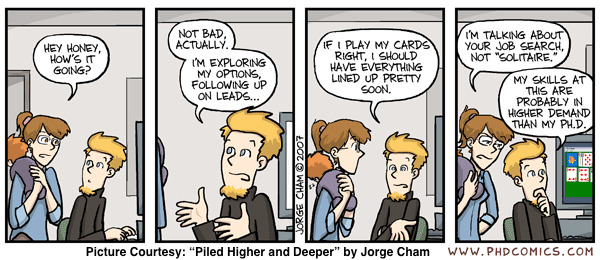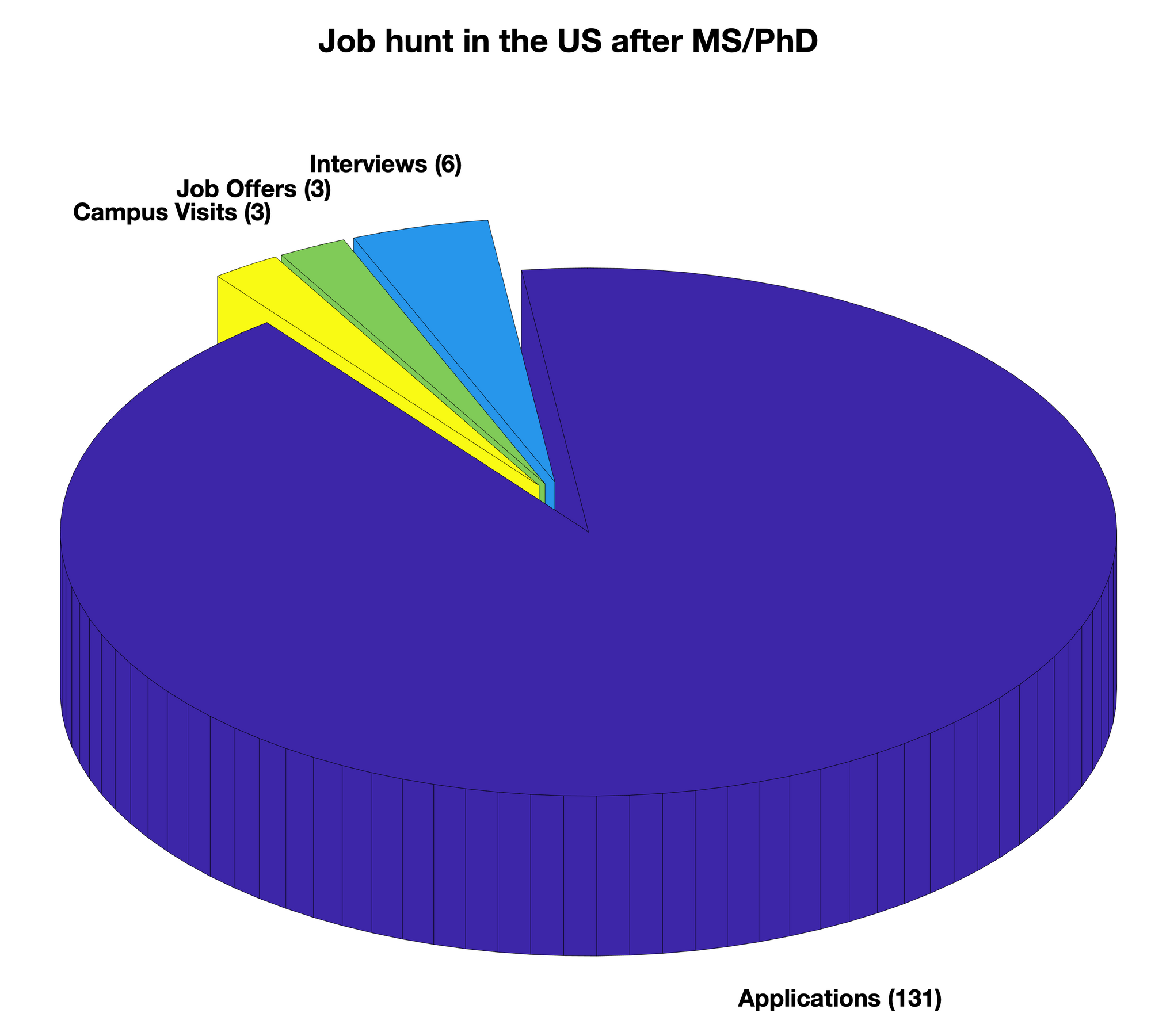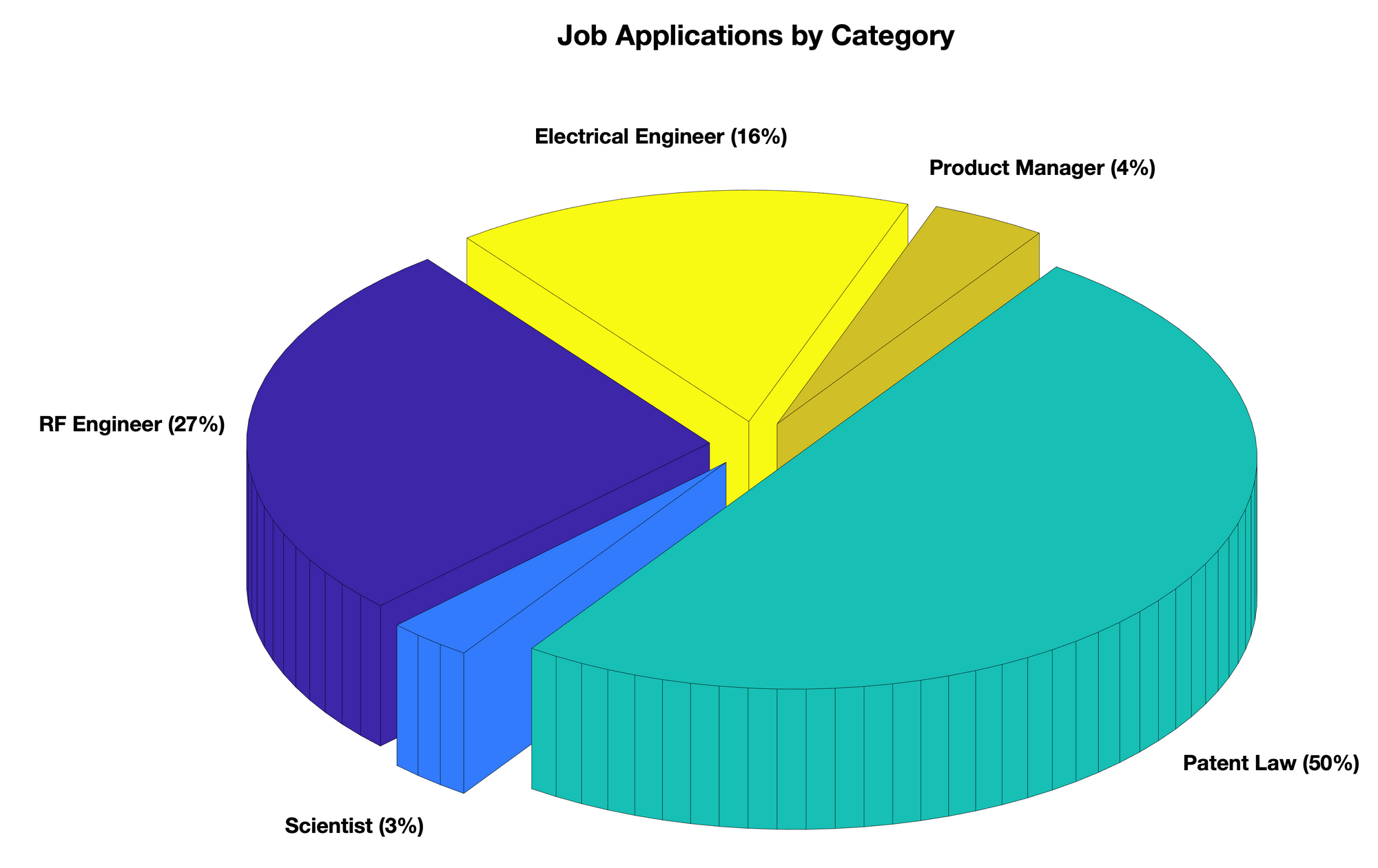Job Hunt in the US after MS/PhD: A Method to the Madness
Although the article is primarily focused on graduate students in the US, these suggestions should work well for any job aspirant in general. The only caveat to the above assertion is that the technological & cultural differences in different countries might hinder optimal results.

Having barely survived my PhD, I was extremely nervous about my future. I wasn't sure if anybody would hire me. I wasn't even sure if I was hireable in the first place. To make matters worse, as an international student, you have ninety days to find a job after graduation (thanks to immigration rules). So, there is a clock counting down from the moment you graduate. By any measure, I wouldn't call myself an extraordinary student. And yet, a methodical approach to job hunting helped me find the job of my liking.

Interestingly, I was spoilt for choices as I had three job offers. I documented my efforts along the way to share them here, hoping that it might be of use to my readers. In all, I applied to 131 jobs. I had the opportunity to interview with six different employers, three campus visits and finally, three job offers. Although the article is primarily focused on graduate students in the US, these suggestions should work well for any job aspirant in general. The only caveat to the above assertion is that the technological & cultural differences in different countries might hinder optimal results. I sincerely believe that these suggestions, tips and tricks will substantially increase your chances of landing a job of your liking. For the curious reader who is not a job seeker, I hope this article is insightful, funny and informative, at least in parts.
Identify your Core Expertise & Expand around it.
As I began my job hunt, I was seriously considering opportunities beyond traditional scientific careers. My core expertise was in RF & Electromagnetics. I was also interested in exploring patent law as a career option. I could leverage my PhD and work as a Technical Specialist or Patent Agent at law firms (more on that in a different article).

Many positions in my core expertise area are reserved for US citizens. I went ahead and registered on every significant job portal and started applying to positions that belonged to these categories (see figure above). I also applied to a few other tangential, exotic and irrelevant fields to cover all my bases.
Unless you are Elon Musk, use a one-page resume.
During my job search, every time a recruiter asked students to send a one-page resume, there was inevitably a guy or a girl in the group who asked, 'Can my resume be two pages?' The recruiter was kind enough to oblige, but it defeated the instruction in the first place. For most jobs right after graduation, you should have a one-page resume with two exceptions: if you have five-plus years of experience or a PhD applying for academic or research roles. Is this a deal-breaker? No. It isn't. Almost no rule is a deal-breaker in a job hunt. But complying with some basic industry standards goes a long way in making your profile stand out. I was familiar with all this wisdom and yet felt the urge to prepare a two-page resume until I saw this quote on a job website: 'Unless you are Elon Musk, use a one-page resume.' It settled all my confusions once for all.
Once the question of size is dealt with, we can turn our attention to the resume's content. More often than not, a tendency to write all work duties dominated the content of my resume. But, almost everyone who is doing the same job has the same set of responsibilities. Thanks to Resume Preparation workshops, I learnt that rather than listing tasks & duties, writing about my contribution to those duties in measurable metrics goes a long way in differentiating my application from the rest. For example,
Modelled the inductor parasitic losses. Designed a high-efficiency inductor. Tested and verified the design concept for high efficiency.
could be written as
Designed a novel megawatt-class high-efficiency inductor to ensure 99% power is delivered to the load. Modelled inductor parasitics like proximity effect & self-resonance to reduce winding losses on ANSYS Maxwell. Built, tested and verified the design for 90% efficiency at 3 MHz
Almost anybody with a high school degree can build an inductor. It takes skill to make a highly efficient inductor. But, highly efficient is an abstract term. Without a measurable metric, it gives little insight into my work. However, a megawatt-class inductor with 99% efficiency at 3 MHz tells an entirely different story. It provides excellent insight into my work. By describing the modelling efforts and the tools used, I showed my ability to skillfully use industry-standard software.
Finally and most importantly, your resume should be tailored to the job you are applying for. In the initial days of my PhD, I was hunting for job opportunities on campus until I found my research group. I would apply to librarian positions, administrative assistant positions and sent them the standard resume that got me a PhD admit (if it was good enough for a PhD, it should be good enough for a librarian). Inevitably, I would be rejected in a day or two. While my resume showcased my stellar skills as a programmer & engineer, it had nothing to speak for my ability to perform the role of a librarian or administrative assistant. I learnt my lesson the hard way.
Network Shamelessly: Leverage LinkedIn & personal contacts
Once you have identified your core expertise & tailored the resume to your dream job, network shamelessly. Yes, you heard that right. There are two paths to find the right network of people. At first, reach out to your personal contacts. If you know a friend in the company you want to work for, call them up. If you see an ex-colleague who works at your dream company, call them up or write them an email.

Up next, leverage LinkedIn to your advantage. If you have updated your LinkedIn profile with all your workplaces and positions, you can check out the homepage of the dream company you want to work for. There is a decent chance you will find your friends & colleagues from the past who work there presently. If not friends or colleagues, you will discover somebody who graduated from the same university as you.

Lastly, if you find absolutely nobody with a shared background, you can always jump to the people page and filter out people based on job titles, universities, locations, etc.

Ultimately, you will have to make the uncomfortable move to ask for help. In my personal experience, people are more than willing to help. For example, to interview with my present employer (ORNL), I reached out to a colleague (a fellow PhD) who works here at ORNL. Even though my interactions with her were minimal during our university days, she was kind enough to find the right team and forward my resume to my present boss. There is a fair chance that a good majority of your contacts might not help. But, the more people you reach out to, the better are your chances. In the two and a half months of my intense job search process, I sent out 135 new connection requests on LinkedIn. So, I repeat it. Network shamelessly.
Network Smartly: Informational interviews
The biggest obstacle that I encountered while networking was how do I start the process? What do I exactly do when I am networking? What happens when the contact accepts my request? How do I increase the chances of somebody responding to my connection invitations? It turns out there is an intelligent way of going about all of these questions.
Connect with a personalized message: Once you identify the person of interest, send out a personalized message with the connection request. A connection request with a personalized message has a higher chance of being accepted than without one. A sample message is shown below.
Hi John, I am Amith Narayan, a PhD candidate in the ECE Dept at UMD. I plan to graduate this Fall 2019. Presently, I am exploring career options outside of academia. I am interested in learning more about your career transition from academia to patent law. Let's connect.
Set up an informational interview: Once you are connected, request a short informational interview with the contact (about 20 minutes). An informational interview is an informal conversation you can have with someone working in an area of interest. It is not a job interview, and the objective is not to find job openings.

These interviews help you connect with people personally and learn about the industry in general, changing careers, company culture, seeking referrals & your contact's job role. A sample set of questions are shown in the picture above. LinkedIn has some excellent course material on informational interviews (take advantage of the one-month free trial). Occasionally, your contact might ask for your resume at the end of such conversations. Ensure that you have it ready to send at the exact moment they ask. My second job offer with a Patent Law firm was through one such informational interview.
At last, prepare for the typical interview questions, which are behavioural (for example, tell me about yourself). With a bit of preparation, these questions can make the interview a fantastic experience for everybody involved. LinkedIn provides free access to an exhaustive question bank for everyone. It also offers valuable suggestions on how to approach these questions.
Conclusion: Identify your Unfair Advantages & Double Down
In the book The Unfair Advantage by Ash Ali & Hasan Kubba, the authors make a highly provocative and yet very pertinent point about success in our life's endeavours. They say that the world is fundamentally unfair in many ways that cannot be rectified with any policy framework. These unfair advantages could be money, intelligence & insight, place of birth, education & expertise or your social status (MILES framework). The key is to identify our unfair advantages and double down to achieve success. I will conclude this article with two anecdotes.
Evan Spiegel was born into a very wealthy family, received expensive private school education in LA, attended college at Stanford University, knew venture capitalists like Peter Wendell through family connections. He made the best use of all these advantages and founded Snapchat and sold it to become a billionaire at 24. On the other hand, Jan Koum, a Ukraine born immigrant, moved into a US house provided by social services. He founded WhatsApp using his strong expertise as a computer programmer. He sold it to Facebook for 19 billion dollars. These people are opposites in many ways, yet both of them achieved great success in their endeavours because they doubled down on their unfair advantages.
Finally, I will share a personal experience in this regard to drive home the point. I went through every step mentioned above for two and a half months with great determination. Finally, I landed a job at ORNL, my friend and a fellow PhD student in my research group landed an interview at ORNL because I forwarded his resume to the appropriate team. He was smart enough to land a much better offer than me, even though his job search began and ended with ORNL. So, the bottom line is, 'Life is unfair, Do not despair; there isn't another you anywhere.'
Full Disclosure: Some of the links on this site are affiliate links, meaning, at no additional cost to you, I will earn a commission if you click through and make a purchase. But feel free to not use them.
